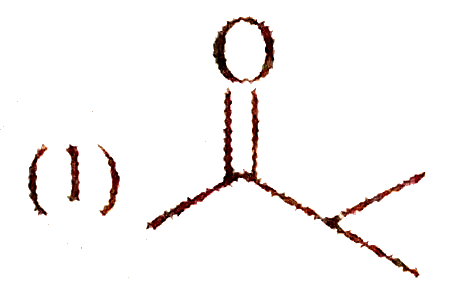Total number of final product(s) (including isomers) in the following conversion is/are:
H3C−CH3∣C∣Br−CH3∣C∣Br−CH3Nal−−−−−−−→CH3COCH3(A)NBS(1 equivalent)/(hv)−−−−−−−−−−−−−−−→?
The correct Answer is:2
To solve the question regarding the total number of final products (including isomers) in the given conversion, we will break down the process step-by-step.
Step 1: Understand the Starting Material
The starting material is a compound with two bromine atoms attached to a carbon chain, specifically:
H3C−Br|H3C−C−Br|H3C
This structure indicates that we have a symmetrical compound with two bromine substituents.
Step 2: Reaction with NaI
The first step involves a reaction with sodium iodide (NaI), which typically leads to an intramolecular nucleophilic substitution. In this case, the bromine atoms will be replaced by iodide ions, leading to the formation of a double bond.
Step 3: Formation of the Double Bond
During the intramolecular reaction, both bromine atoms are removed, and a double bond is formed between the two carbon atoms that were previously bonded to the bromine atoms. The structure now looks like this:
H3C−CH=CH−CH3
This is a simple alkene.
Step 4: Reaction with NBS (N-Bromosuccinimide)
Next, the alkene undergoes a free radical bromination in the presence of NBS and light (hv). This reaction can lead to the formation of different products depending on where the bromine adds to the double bond.
Step 5: Identify Possible Products
1. Product 1: If bromine adds to one of the terminal carbons, we get:
H3C−CH=CH−CH2−Br
2. Product 2: If bromine adds to the other terminal carbon, we get:
H3C−CH2−CH=CH−Br
Step 6: Check for Isomers
Next, we need to check if these products can have geometric (cis/trans) isomers or if they are chiral:
- The first product does not have any chiral centers and cannot exhibit geometric isomerism because both substituents on the double bond are not different.
- The second product also does not have any chiral centers and cannot exhibit geometric isomerism for the same reason.
Conclusion: Count the Final Products
After analyzing the products formed:
- We have two distinct products from the reaction.
- Neither product has isomers due to the lack of chiral centers and geometric isomerism.
Thus, the total number of final products (including isomers) is 2.
Final Answer
Total number of final products = 2.
The starting material is a compound with two bromine atoms attached to a carbon chain, specifically:
H3C−Br|H3C−C−Br|H3C
This structure indicates that we have a symmetrical compound with two bromine substituents.
The first step involves a reaction with sodium iodide (NaI), which typically leads to an intramolecular nucleophilic substitution. In this case, the bromine atoms will be replaced by iodide ions, leading to the formation of a double bond.
During the intramolecular reaction, both bromine atoms are removed, and a double bond is formed between the two carbon atoms that were previously bonded to the bromine atoms. The structure now looks like this:
H3C−CH=CH−CH3
This is a simple alkene.
Next, the alkene undergoes a free radical bromination in the presence of NBS and light (hv). This reaction can lead to the formation of different products depending on where the bromine adds to the double bond.
1. Product 1: If bromine adds to one of the terminal carbons, we get:
H3C−CH=CH−CH2−Br
2. Product 2: If bromine adds to the other terminal carbon, we get:
H3C−CH2−CH=CH−Br
Next, we need to check if these products can have geometric (cis/trans) isomers or if they are chiral:
- The first product does not have any chiral centers and cannot exhibit geometric isomerism because both substituents on the double bond are not different.
- The second product also does not have any chiral centers and cannot exhibit geometric isomerism for the same reason.
After analyzing the products formed:
- We have two distinct products from the reaction.
- Neither product has isomers due to the lack of chiral centers and geometric isomerism.
Total number of final products = 2.
Topper's Solved these Questions
- GENERAL ORGANIC CHEMISTRYBOOK - FIITJEECHAPTER - GENERAL ORGANIC CHEMISTRYEXERCISE - NUMERICAL BASED QUESTIONS
12 Videos
- GASEOUS STATEBOOK - FIITJEECHAPTER - GASEOUS STATEEXERCISE - MATCHING LIST TYPE QUESTION
1 Videos
- HYDROCARBONSBOOK - FIITJEECHAPTER - HYDROCARBONSEXERCISE - SINGLE INTEGER ANSWER TYPE QUESTION
9 Videos
Similar Questions
Knowledge Check
CH3−CH3∣C∣OH−CH3∣C∣NH2−CH3HNO2−−−→Δ?
A B
B C
C D
D
The major product of the following reaction is:
CH3−CH3∣C∣H−CHCH3∣BrCH3OH−−−−→ACH3−CH3∣C∣H−CHCH3∣OCH3BCH3−CH3∣C=CHCH3CCH3−CH3∣C∣OCH3−CH2CH3DCH3−CH3∣C∣H−CH=CH2CH3−Br+NaO−CH3∣C∣CH3−CH3→ ?
ACH3−O−CH3∣C∣CH3−CH3BCH3−CH2∣∣C∣CH3CCH2=CH2DCH3−O−CH∣CH3−CH3
CH3−CH3∣C∣CH3−CH2−C∣∣O−NHCH3
View SolutionWrite down the derived names of the following:
CH3−CH3∣C∣CH3−H∣C∣H−CH∣CH3−CH3
View SolutionThe IUPAC name of
CH3Ch2−H∣C∣CH3−C4H9∣C∣CH3−CH3
is
View SolutionH3C−CH3∣C∣CH3−C∣OHH−CH3HBr−−→(A) Product (A) is
View SolutionCH3−CH∣CH3−Cl∣C∣H−CH3CH3OH−−−−→ major product is
View Solution
